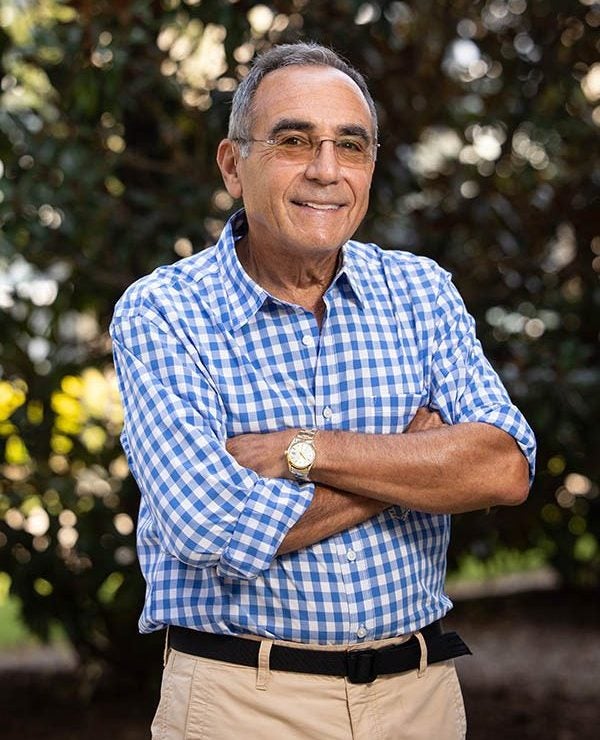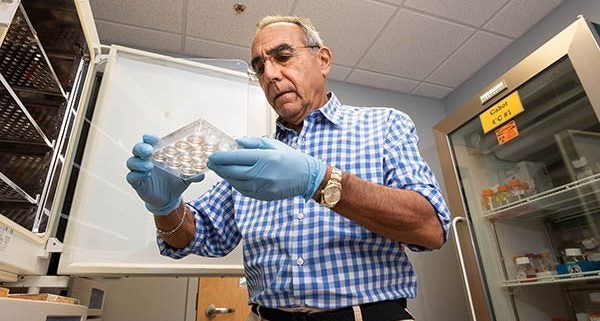5 questions with ECU leukemia researcher Myles Cabot

Dr. Myles Cabot, a professor in Brody’s Department of Biochemistry and Molecular Biology, is leading a National Cancer Institute Program Project Grant aimed at exploring therapeutics for an aggressive type of leukemia. (Photos by Rhett Butler)
As project leader for a recently renewed National Cancer Institute Program Project Grant focused on exploring therapeutics for acute myeloid leukemia (AML), Dr. Myles Cabot brings another perspective of national research collaboration to the Brody School of Medicine at East Carolina University.
Cabot is a professor in Brody’s Department of Biochemistry and Molecular Biology, and the East Carolina Diabetes and Obesity Institute.
Cabot’s lab is continuing the ongoing research led by the University of Virginia that also includes Penn State Health Milton S. Hershey Medical Center, Memorial Sloan Kettering Cancer Center and the University of New Hampshire. Their combined work has resulted in current and future clinical trials for treating AML, a particularly aggressive blood cancer.
Cabot, a lipid biochemist and cancer cell biologist, has published extensively on the development and reversal of multidrug resistance in cancer. Research in his lab focuses on sphingolipid metabolism, an area of cancer research that has risen to clinical prominence. Ceramide, the aliphatic backbone of sphingolipids, acts as a powerful tumor suppressor, whereas its glycosylated product, glucosylceramide, catalyzed by the enzyme glucosylceramide synthase (GCS), is anti-apoptotic and a biomarker of chemotherapy resistance, as discovered by Cabot and colleagues.
Cabot earned a Ph.D. at The Hebrew University, Hadassah Medical School, Ein Karem, Jerusalem, Israel, in 1976. Between 1976-1978, he was a Damon Runyon-Walter Runyon Postdoctoral Fellow in Cancer Research, Oak Ridge Associated Universities, Oak Ridge National Laboratories, Oak Ridge, Tennessee.
Cabot answered five questions about his current research and the recently renewed National Cancer Institute Program Project Grant.
Q. What is the background of the research that you are continuing at ECU?
A. Sphingolipids, a class of lipids that contain ceramide as the central building block, have become increasingly important therapeutic targets in the treatment of cancer. This is because ceramide is cytotoxic in cancer cells but not in normal cells of the body, a good thing. However, on the downside, cancer cells have ‘learned to metabolize’ ceramide, thus negating its anticancer impact.
My collaborators at UVA have engineered a nanoparticle that contains a high concentration of a ceramide analog (C6-ceramide). They have termed this particle “CNL,” for ceramide nanoliposome. Although CNL can be effective as a single agent, and nano-formulation allows for high-dose delivery, efficacy as a therapeutic can be limiting, depending on the ceramide-metabolizing machinery inherent in the type of cancer we are dealing with.
My work with UVA Cancer Center and Penn State/Hershey Cancer Institute focuses on ways to limit ceramide metabolism in cancer, and thus make it a more effective therapeutic. We are using acute myeloid leukemia as a model. By limiting ceramide metabolism, using small molecule pharmacological approaches, we have shown that we can synergistically enhance CNL anticancer properties. Other ways to enhance CNL efficacy are to partner it with agents that can produce synergy.”
Q. What are the goals for the grant renewal effort?
A. Goals in the grant renewal effort focus on deciphering CNL mechanism of action and designing modes to improve therapeutic efficacy, my expertise. This research is a team effort supported by Program Project Grant, now in its seventh year, from the National Cancer Institute. ECU is the recipient of funds for my work on this comprehensive, collaborative endeavor.
My strong relationship with cancer centers at UVA and Penn State/Hershey can serve to stimulate collaborative crosstalk with ECU’s Brody School of Medicine in matters of cancer research, nano drug technology (the nanoSTAR Institute, UVA, Charlottesville), and cancer therapeutics. Notably, there is the potential for Brody to be included in an FDA-approved clinical trial of CNL in patients with acute myeloid leukemia.”

Dr. Myles Cabot is a professor and researcher in Brody’s Department of Biochemistry and Molecular Biology, and the East Carolina Diabetes and Obesity Institute.
Q. What are some of your lab’s accomplishments that contribute to understanding and success of sphingolipids as therapeutics?
A. We have shown that chemotherapy drugs, such as Taxol, elicit ceramide formation, a step toward elicitation of programmed cancer cell death, a good thing.
We have also:
- Determined that controlling ceramide metabolism is key in enhancing the efficacy of certain types of anticancer agents.
- Determined that ceramide glycosylation (addition of a sugar molecule) is the principal pathway of ceramide neutralization in chemotherapy resistant cancer. This presents us with a “target” for overcoming chemotherapy resistance, the most common cause of cancer treatment failure.
- Demonstrated that glucosylceramide synthase (GCS), the enzyme that catalyzes ceramide glycosylation, is a druggable target for reversing chemotherapy resistance.
- Discovered that off-target actions of Tamoxifen, an antiestrogen used to treat breast cancer, inhibit GCS activity and sensitize cancer cells to chemotherapy drugs.
- Shown that chemotherapy resistance via drug selection pressure, alters sphingolipid composition and mitochondrial bioenergetics. These results again provide us with druggable “targets” for treatment of cancer. In general, sphingolipids play a prominent role in chemotherapy resistance. This knowledge provides us with avenues for development of novel therapies.
- Determined that antagonizing P-glycoprotein, a major player in chemotherapy resistance, enhances sphingolipid-based cancer therapy.
Q. What are your hopes for your current research?
A. The Program Project team is looking forward to the results from the Clinical Trial with CNL for treatment of AML. This trial complements a completed 3-x-3 escalating dose trial with CNL as a monotherapy in solid tumors, where nearly 50% of treated patients exhibited stable disease without dose-limiting toxicities. We hope to initiate a CNL Clinical Trial in AML, at Brody, for the eastern North Carolina catch basin.
We hope to improve CNL efficacy, as the best chemotherapy usually consists of poly-drug combinations that synergize. We have recently discovered that drugs used to treat diabetes, metformin and phenformin, synergize with CNL, with striking efficacy. This phase of the work is a collaborative effort with Dr. Kelsey Fisher-Wellman’s lab, East Carolina Diabetes and Obesity Institute, the Department of Physiology, Brody School of Medicine. This is exciting work with limitless prospects. We are currently deciphering the mechanism of action of this novel drug combination and intend to test it in liquid as well as solid neoplasms.
Q. What brought you and your research expertise to ECU?
A. Although a Boston native, I was raised in High Point and graduated from Western Carolina University. After 22 years at the John Wayne Cancer Institute, in Santa Monica, California, I decided it was time to return to North Carolina. ECU and the Brody campus provide a stimulating atmosphere for discussion, collaboration and research in the medical sciences. The Health Sciences Campus is an ideal place to walk, talk, and do science.